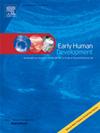Experience with stem cell therapy in neonates: Hope or disappointment?
IF 2
3区 医学
Q2 OBSTETRICS & GYNECOLOGY
引用次数: 0
Abstract
Background
Mesenchymal stem cell (MSC) therapy offers a novel treatment option for neonatal diseases. This study aimed to evaluate the clinical characteristics, efficacy, and early prognosis of neonates treated with MSC therapy in Turkiye.
Methods
This retrospective, cross-sectional study included neonates treated with MSC therapy at multiple centers from 2015 to 2022. Data included antenatal, natal, and postnatal characteristics, MSC therapy indications, timing, dosage, treatment response (such as reduction in respiratory support or extubation within 72 h) and pre/post-discharge evaluations.
Results
MSC therapy indications in 29 cases included bronchopulmonary dysplasia (BPD, n = 21), intraventricular hemorrhage (IVH, n = 9), and necrotizing enterocolitis (NEC, n = 6), with seven treated for two diagnoses. For those treated for BPD, mean ± SD gestational age was 262/7 ± 14/7weeks (233/7–281/7) and birth weight was 784 ± 235 g (420–1470). Five received simultaneous treatment for Grade 3 IVH, and one for Stage 3 NEC. Median MSC therapy start was 33 days (7–181), with routes including intratracheal+intravenous (n = 15), intratracheal (n = 4), and intravenous (n = 2). Median MSC dose was 1x107cells/kg, with 43 % receiving repeated treatments. Seventeen (81 %) responded to treatment at varying levels, with higher antenatal steroid use in responders (p = 0.021). All treated >30 days had severe BPD, while 5/9 treated ≤30 days had severe BPD (p = 0.021). Treatment ≤30 days was associated with discharge, whereas 5/12 treated >30 days died (p = 0.045). At a median of 9 months, 31 % of survivors had neurodevelopmental delay.
Conclusion
Early MSC treatment in BPD is promising, but larger randomized controlled trials are required to better define optimal timing, dosage, and long-term outcomes.
新生儿干细胞治疗的经验:希望还是失望?
背景间充质干细胞(MSC)治疗为新生儿疾病提供了一种新的治疗选择。本研究旨在评估土耳其新生儿骨髓间充质干细胞治疗的临床特点、疗效和早期预后。方法本回顾性横断面研究纳入了2015年至2022年在多个中心接受MSC治疗的新生儿。数据包括产前、出生和产后特征、MSC治疗适应症、时间、剂量、治疗反应(如72小时内呼吸支持或拔管减少)和出院前/出院后评估。结果29例smsc治疗指征包括支气管肺发育不良(BPD, n = 21)、脑室内出血(IVH, n = 9)、坏死性小肠结肠炎(NEC, n = 6),其中7例治疗2种诊断。BPD治疗组的平均±SD胎龄为262/7±14/7周(233/7-281/7),出生体重为784±235 g(420-1470)。5名3级IVH患者同时接受治疗,1名3期NEC患者同时接受治疗。MSC治疗的中位起始时间为33天(7-181天),途径包括气管内+静脉注射(n = 15)、气管内(n = 4)和静脉注射(n = 2)。MSC的中位剂量为1 × 107个细胞/kg, 43%接受重复治疗。17例(81%)对不同水平的治疗有反应,反应者产前类固醇使用较高(p = 0.021)。治疗≤30天的患者均为重度BPD,治疗≤30天的患者中有5/9为重度BPD (p = 0.021)。治疗≤30 d者出院,治疗≤30 d者死亡5/12 (p = 0.045)。在平均9个月的时间里,31%的幸存者有神经发育迟缓。结论:早期骨髓间充质干细胞治疗BPD是有希望的,但需要更大规模的随机对照试验来更好地确定最佳时间、剂量和长期结果。
本文章由计算机程序翻译,如有差异,请以英文原文为准。
求助全文
约1分钟内获得全文
求助全文
来源期刊

Early human development
医学-妇产科学
CiteScore
4.40
自引率
4.00%
发文量
100
审稿时长
46 days
期刊介绍:
Established as an authoritative, highly cited voice on early human development, Early Human Development provides a unique opportunity for researchers and clinicians to bridge the communication gap between disciplines. Creating a forum for the productive exchange of ideas concerning early human growth and development, the journal publishes original research and clinical papers with particular emphasis on the continuum between fetal life and the perinatal period; aspects of postnatal growth influenced by early events; and the safeguarding of the quality of human survival.
The first comprehensive and interdisciplinary journal in this area of growing importance, Early Human Development offers pertinent contributions to the following subject areas:
Fetology; perinatology; pediatrics; growth and development; obstetrics; reproduction and fertility; epidemiology; behavioural sciences; nutrition and metabolism; teratology; neurology; brain biology; developmental psychology and screening.
 求助内容:
求助内容: 应助结果提醒方式:
应助结果提醒方式:


